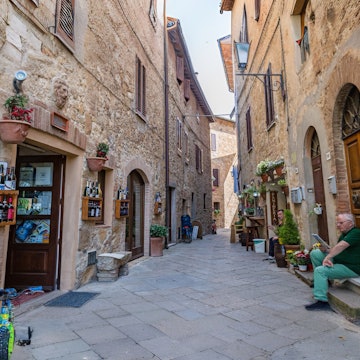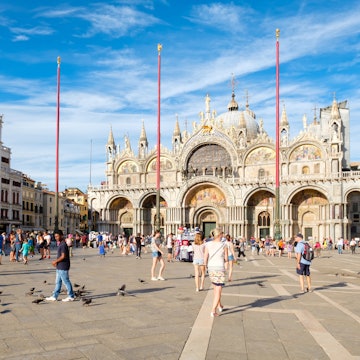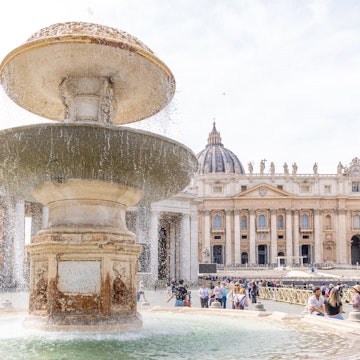

Ruins of ancient Greek theater in Taormina with Mt Etna beyond in Sicily, Italy. Vadym Lavra/Shutterstock
Something of a mini-continent, the island of Sicily in Italy ticks most boxes. Whether you're an adventurer, art lover, beach bum, or ruin explorer, this rugged chunk of sun-spun land at the crossroads of the Tyrrhenian, Ionian and Mediterranean seas has enticed ancient and modern peoples with its charms since time immemorial. The result: one of Europe's richest and most extraordinary histories, with an unmatched booty of artistic and drop-dead-gorgeous natural treasures. The food and drink isn't bad either.
Turquoise cove to ridgetop temple. Byzantine mosaics to chubby-cheeked baroque putti (cherubs). Windswept olive and lemon groves and dry, parched gardens planted with pomegranate, fig and carob trees. Traveling around Sicily might feel like extreme sensory overload but it exudes Sicilian dolce far niente (sweetness of doing nothing).
July and August are the busiest months, but every month has its own beauty. The very real temptation of simply eating and drinking your way around Sicily aside, here are nine top things to see and do on the island.

1. Discover Sicily's backstory in a kaleidoscope of UNESCO mosaics
Scantily clad Olympians, African animals, lepers, deities, mythical monsters, Adam and Eve: the wild stories told by Sicily's Herculean cache of Roman, Byzantine and Arab-Norman mosaics will have you hooked for days. Begin your mosaic mini-tour in the glittering gold cathedral crowning the hilltop Monreale, built for William II in 1184 to upstage grandfather Roger II's magnificent building accomplishments in Cefalù (Duomo di Cefalù) and Palermo (Cappella Palatina). Continue the mosaic fest in Villa Romana del Casale, a Roman patrician's palatial country pad a couple of hours' drive inland.

2. Adventure up Sicily's "other" volcano on Stromboli
Hiking or mountain biking up the emblematic slopes of massive, brooding Mt Etna is a classic. But if you're into a fire-spitting volcano with a primordial village vibe and post-hike pizza with fireworks, hit the less-sung Stromboli – legend says that wind god Aeolus and other mythological deities had a hand in this island's marvelous creation. But a guided trek at sunset from the whitewashed village up charred slopes shows the harsh reality of living next to a volcano, a tempestuous environment ruled by Mother Nature alone. From the smaller volcano's Sciara del Fucco viewpoint at 400m, only accessible with a guide, watch red-hot rocks roll down the lava-charred mountainside into the sea, and then hike back down by torchlight.

3. Wander ancient ruins in the Valley of the Temples by moonlight
On Sicily's southern Mediterranean coast, Agrigento's Valley of the Temples makes an impression like no other ruins on the island. Strung out along a long rocky promontory where the ancient Greeks built sacred temples as holy beacons for sailors 2500 years ago, the vast archaeological site is prized by UNESCO as one of the world's "most outstanding monuments of Greek art and culture." The magic peaks on summer evenings when the moon casts the ruins in a celestial, iridescent light, and the wind plucks tunes on the columns of ghostly Doric temples.
Planning tip: Sicily's flush of ancient Greek ruins runs deep. Add hilltop Segesta and sea-facing Selinunte, both in western Sicily, to your long weekend itinerary to bag the hat trick.

4. Taste vino with winegrowers on the slopes of Mt Etna
Sun-soaked grapes have always been grown on the island – this is Italy's second-largest wine-producing region, after all. But with the exception of sweet dessert wines like Marsala, Sicilian wines are hard to come by outside Sicily. Drink in local viticulture, meet wine growers and swill, sniff and sip wines produced on Mt Etna's fertile slopes along the Strada del Vino dell'Etna (Etna Wine Road). This is not a road at all but a deliciously scenic train journey peppered with sumptuous villa-wineries along the lower slopes of Europe's largest active volcano.
Planning tip: The Strada's wine trains depart twice weekly from Riposto, an hour's drive from Catania on the Ionian Coast. Tickets include a guide and bus transfers to wineries for degustazione (tasting).

5. Splash and snorkel like a 1960s movie star on Isola Bella
Vintage glamour queen Taormina is the springboard for chic sea dips and snorkeling forays in crystal water that laps the pebble beach on Isola Bella – as bella (beautiful) as its name suggests. The dot of an island, linked by cable car to Taormina (which is perched dramatically on a cliff high above), lured Europe's aristocracy during the days of the Grand Tour and the literati likes of DH Lawrence in the 1920s. Glitzy views of smoking Mt Etna and the Ionian Sea vie for the spotlight during summertime theater performances in its resplendent ancient Greek amphitheater.
Planning tip: Taormina gets packed to bursting in July and August and all but shuts down between November and Easter. April, May, September and October are best.

6. Learn about Mafia past and present in Palermo
Try to better understand what makes Sicily's disheveled, high-octane capital tick at No Mafia Memorial, a multimedia space in a palazzo on Palermo's main street Corso Vittorio Emanuele that explains Mafiosi and anti-Mafia history. Combine the interesting if unsettling exhibitions with a contemplative walk along the powerful Wall of Legality street mural in rough-and-tumble Il Capo; then snap a selfie on the opera-house steps at Teatro Massimo, where the iconic mafia shooting scene from Francis Ford Coppola's Godfather trilogy was filmed.

7. Admire prehistoric art in a cave on Levanzo
When you tire of beach-hopping by bicycle on the Egadi island of Favignana, swap wheels for water and catch a ferry to pin-prick Levanzo. From its tiny port, motorboats whip along the wave-lashed coast to Grotta del Genovese, a cave hidden high in the hillside that shelters Upper Paleolithic and Neolithic rock art. Etchings of goats, dolphins and donkeys reflect farming practices some 12,000 years ago when a vast plain linked to the two islands. Bookend the torch-lit cave visit with huge, glittering sea views.
Planning tip: Cave visits must be booked online at least 48 hours in advance. Ditto in July and August for Liberty Lines hydrofoils to and from Trapani on mainland Sicily and also Favignana. To continue the rock art theme, stay the night on Favignana in rooms at Giardino dell'Impossible, botanical gardens hewn in labyrinthine rock.

8. Uncover the greatest city of ancient Magna Graecia in Syracuse
It's mind-boggling that small town Syracuse in southeast Sicily was the largest city in the ancient world in its heyday – bigger even than Athens and Corinth. A near-perfect encapsulation of Sicily's timeless beauty, its "once upon a time" begins in 734 BCE. Split your time between the ancient island-city of Ortygia – where honey-hued medieval streets flow like ribbons down to the sea and open-air food market brim with lunchtime oysters – and the evocative, citrus-scented ruins of Parco Archeologico della Neapolis.
Planning tip: Bag a golden ticket for theater beneath the stars at Syracuse's supremely well-preserved Greek amphitheater during May–June's Festival del Teatro Greco.

9. Get off-grid on the Aeolian island of Alicudi
Magical and mesmerizing, the Aeolian's second-smallest island feels like a mischievous afterthought on the map. As isolated a place as you'll find in the entire Mediterranean basin, this 5.2 sq km island has no roads – just a relentless succession of time-wizened, volcanic-stone steps staggering mercilessly up to the craggy summit of Monte Montagnola (675m). After you step off the hydrofoil at the sleepy port, simply follow the donkeys and mules uphill – they're the only means of transport on this old-timer island. Post-hike, watch fishermen clean fish and nets or track down a boatman at sundown to bathe in the peace and tranquility of aperitivo al tramonto (early evening drinks at sunset).
















